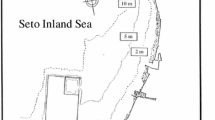Summary
The huge numbers of molluscs, worms and bacteria found in the sheltered tidal flats of the Dutch Wadden Sea, decompose large amounts of organic matter. In this process nutrients incorporated in the particulate organic matter are transferred to the dissolved state. The importance of this process for nutrient budgets was first demonstrated by POSTMA (1954) and later by various authors with emphasis on tidal watersheds and sheltered bays (see Neth. J. Sea Res., 8 (2/3). 1974).
The nutrient budgets of the Balgzand tidal flats, as a typical example of a sheltered bay, have been studied during one tidal period by TIJSSEN and VAN BENNEKOM (1976) and recently for a longer period in a cooperative project by the “Studiedienst Hoorn” of “Rijkswaterstaat” (DE BOER, 1978) and the Netherlands Institute for Sea Research (MANUELS, 1978). A qualitative measure for the high intensity of mineralization are the high concentrations of nutrients in the water on the Balgzand, compared to those in the Marsdiep (Table I).
Simple box models can be used to derive the intensity of nutrient production from the concentration differences in which also the water depth and the exchange velocity of the water with adjacent areas contribute. As a first approximation all mineralization is thought to be situated in the surface sediment (VAN BENNEKOM et al., 1974) and the characteristics parameter becomes the nutrient production per m2 per day. For reactive silicate this parameter shows a pronounced seasonal cycle. In January, February and Marchin situ production is hardly detectable while in July and August 500 mg SiO2 m−2d−1 is found. For comparison, weathering of soil by rain water gives 4–30 mg SiO2.m−2d−1 with only slight seasonal variations. The difference is at least partially explained by assuming a different source: diatom frustules in the case of the Balgzand and silicate minerals in the case of normal weathering.
The scarce data available indicate that the seasonal cycles of in situ production of phosphate, nitrate and ammonia on the Balgzand are less pronounced than for reactive silicate. The picture is further complicated because ammonia is always produced, but sometimes nitrate is consumed, apparently by denitrification.
The nutrient ratios change during the year (Table II). Especially in summer the contribution of silicate is relatively large. This is in marked contrast with the nutrient ratios in the coastal sea water where during the summer the amount of silicate is relatively low. The nutrient ratios are probably an important factor in the seasonal and regional species composition of the phytoplankton.
Similar content being viewed by others
References
BOER, M, de, 1978. Uitwisseling wadwater Balgzand. Waterloopkundig onderzoek, mei 1977. Rijkswaterstaat, Directie Noord-Holland, Studiedients Hoorn, Nota 78H005, 28 pp. (unpubl. report).
MANUELS, M.W. (ed), 1978. Water-, stof- en warmtehuishouding van het Balgzand, NIOZ Internal Reports 1978-2, 112 pp.
POSTMA, H., 1954. Hydrography of the Dutch Wadden Sea. Archs. néerl. Zool., 12: 405–511.
TIJSSEN, S. B. & A. J. VAN BENNEKOM (1976). Lage zuurstofgehaltes in het water op het Balgzand, H2O, 9: 28–31.
VAN BENNEKOM, A.J., E. KRIJGSMAN-VAN HARTINGSVELD, G. C. M. VAN DER VEER and H. F. J. VAN VOORST, 1974. The seasonal cycles of reactive silicate and suspended diatoms in the Dutch Wadden Sea. Neth.J.Sea.Res., 8: 174–207.
Author information
Authors and Affiliations
Rights and permissions
About this article
Cite this article
Van Bennekom, A.J. The Balgzand (Dutch Wadden Sea) tidal flats as a source of soluble silicate. Hydrobiological Bulletin 12, 143–144 (1978). https://doi.org/10.1007/BF02260716
Issue Date:
DOI: https://doi.org/10.1007/BF02260716




